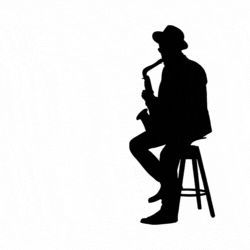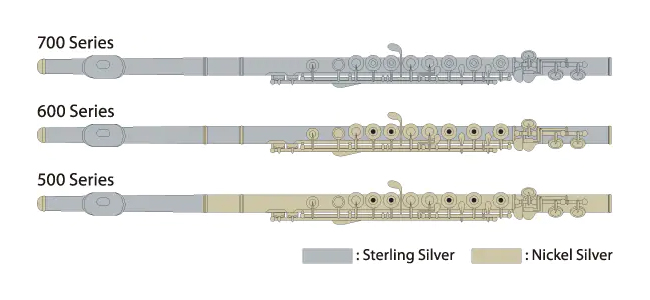
Your shopping cart is currently empty.
YFL-567HCT
Inheriting the many merits of top-of-the-line Yamaha handmade flutes.
Combining the brilliance of nickel silver with the characteristic mellow timbres of sterling silver, the 587H offers rich, nuanced tonality over a wide dynamic range. The 587H also has a hand-finished headjoint based on the Type A headjoints supplied with the 800 and 900 series handmade flutes. The keys feature traditional pointed key arms, reflecting the highest level of craftsmanship and adding visual elegance to this outstanding instrument.
500 Series Features:
Hand-finished Headjoint
Based on the Handmade Flute’s Type A design which offers a wider expressive range, the hand-finished headjoint on Yamaha professional flutes additionally offers easier response and excellent balance over the instrument’s entire range.
Acoustic Annealing
The headjoint, body and footjoint of all Yamaha professional flutes are heat treated through an annealing process that allows the instrument to vibrate more freely, providing optimal response and beautiful resonance.
Key Design
The keys are hand-assembled and meticulously balanced for a perfect touch, and the key shapes have been so exquisitely designed and ergonomically placed that the flute will almost ‘disappear’ in your hands. Performances will feel effortless and natural.
Pointed Key Arms
A#, F# and other non-fingered keys feature pointed key arms, similar to those found on Handmade Flutes. Their beautiful designs are inspired by traditional European styling.
Case
The compact case provides ease of transport and excellent protection from damage. All Yamaha professional flutes come with an elegantly designed case cover.
Material Combination for Yamaha Professional Flutes

*All models are silver-plated.
Options
Individual flute models may be available with a number of variations: different headjoints, mechanisms, key types, or footjoints. All of these components affect the instrument’s sound, playability, and overall feel.
Headjoint
Because the player’s breath enters the instrument via the headjoint, it is a vital component that has a large influence on a flute’s basic character. The shape, size, material, and other attributes of the lip plate and embouchure affect tone and playability.
Type Am
Based on the Handmade Flute’s Type A design, which offers a wider expressive range, the Type Am headjoint additionally offers easier response and excellent balance over the instrument’s entire range, lightly heavier resistance, and a wide.
Key Types
There are two types of keys for the flute: covered keys (German style) and ring keys (French style). Each type has its own characteristics.
Covered Keys
Since the key cups are lid-shaped, the keys properly cover the holes, preventing the player’s breath from escaping.
Ring (French) Keys
Since the key cups are ring-shaped, covering the holes properly requires technique. However, since the player can directly feel the air vibrations on his fingertips, he can control the subtle nuances of the sound. There is also the appeal that techniques such as finger-sliding allow considerable freedom to vary the pitch. The glissando technique is also available, in which a run of notes is played by gradually opening a key hole.
G-key Alignment
There are two options for the G-key alignment: Offset, and In-line. Each type has its own characteristics.
Offset G
The G key protrudes in a way that makes it easier to play with the left-hand ring finger.
In-line
The keys are arranged in a straight line that is not only visually attractive, but also reduces the number of parts used compared to an offset design, for lighter, more agile action.
Split E Mechanism
Not all flutes have an E Mechanism. The basic structure of a flute can make the third-octave E note difficult to produce, so a special “E Mechanism” key system is provided on some models to make it easier.
On flutes that do not have an E Mechanism, the player will sometimes press the adjacent G# key when spreading the left-hand ring finger to play the third-octave E, interfering with proper production of the E note. The E Mechanism prevents this from happening by automatically closing the G# key when the E is fingered.
Trill Keys
C♯ Trill Key
An additional lever and Tone Hole which are useful for B to C# trills, but can also be used to facilitate a number of other trills and tremolos. * Incompatible with G/A trill key
G/A Trill Key
This aids in trilling from G to A. * Incompatible with C# trill key or Clutch E Mechanism.
Footjoint
There are two options for the footjoint: C or B. Each type has its own characteristics.
Some models are available with a C or B footjoint*. The B footjoint lowers the instrument’s lowest note to B while also producing a slightly different tone because of its extra length. Some players choose the B footjoint solely for its tone. The C type joint sound brighter, while the B joint has a darker, more lustrous tone. The B footjoint also features a gizmo key that allows the low B Tone Holes to be closed independently, improving pitch stability in the high register.
* The B footjoint is distinguished by “H” in the model number.
587HCT LPGP Model Features:
Headjoint Type AM
Based on the Handmade Flute’s Type A
design, which offers a wider expressive
range, the Type Am headjoint additionally
offers easier response and excellent balance
over the instrument’s entire range, lightly
heavier resistance, and a wide.
Gold Lip Plate
Gold lends a special glitter to a flute—its remarkably rich, bright tone expands the flutist’s imagination greatly.
Ring (French) Keys
Covered (or Plateau) keys are easy to use. The pad cup is covered so it will seal the tonehole any time the key is closed. This is common with beginners or others who may not always press the center of the key. Many advanced players prefer the open feel of Ring keys for subtle control of their tone. Intermediate and Standard model French system flutes come with key plugs to seal the hole until players have become adept at covering the holes with their fingers.
In-Line G
Many players find the Offset G configuration easier to play. Often teachers recommend that beginners start on these flutes, while more and more advanced players are also choosing this natural feeling configuration. Many advanced students and professionals, though, still prefer the traditional In-line formation where all the toneholes are in a straight row.
C# Trill Key
An additional lever and tonehole which are useful for B to C trills, but can also be used to facilitate a number of other trills and tremolos.
B Footjoint
The B footjoint has an extra key enabling the player to play 1/2 step lower than the lowest note of the C foot. It also affects the sound; B footjoint enables a darker, stronger sound with good projection, while C footjoint has flexible, warmer tone.
YFL-587H Specifications:
| Model: | YFL587HCTLPGP |
| Manufacturer: | Yamaha |